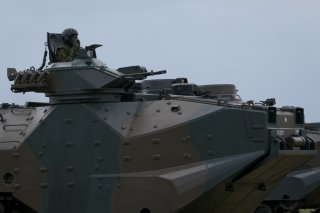An Assault Ship Could Fill the Obvious Gap in Japan’s Fleet Structure
The design is ready.
Here’s What You Need to Remember: “For Japan, even a small fleet of LHDs could allow the Amphibious Rapid Deployment Brigade to flex its muscles more throughout East Asia and elsewhere in the Pacific, where the country has increasingly diverse security concerns,” Joe Trevithick explained at The War Zone.
A Japanese shipbuilder is pitching a new amphibious assault ship that could transport the Japanese military’s new Amphibious Rapid Deployment Brigade marine force and its MV-22 tiltrotors.
Japan Marine United Corporation revealed, at the DSEI Japan 2019 exhibition in Chiba in late November 2019, its design for a new landing helicopter dock, or LHD.
The 19,000-ton-displacement vessel’s design features a floodable well deck for embarking two LCAC air-cushion landing craft plus 20 AAV7A1 amphibious assault vehicles. Its full-length flight deck boasts five marked landing spots for helicopters or tiltrotors. Two below-deck hangars have space for five more rotorcraft.
The crew would number 500. It’s unclear how many troops the ship could embark, but similar vessels in service with other navies typically carry 500 passengers for long missions and up to a thousand for shorter hauls.
The Japanese navy does not have a formal requirement for an LHD, but there’s an obvious gap in the fleet’s structure that an assault ship could fill. Tokyo is building up a force of 17 MV-22 tiltrotors, 52 AAV7s and six LCACs to carry marines into combat. But the landing craft, vehicles and rotorcraft require ships to transport them close to shore.
At present, Japan’s amphibious flotilla includes two Izumo-class big-deck assault ships that Tokyo is converting into light aircraft carriers for embarking F-35B jump jets. Another two light carriers are on order. In addition, the amphibious fleet includes two Hyuga-class helicopter carriers and Osumi-class three landing ship tanks, or LSTs.
The navy is updating the three LSTs to support V-22s and AAV7s. But the LSTs each can carry just 330 troops on long missions. Tokyo’s marine brigade numbers 3,000 personnel. If the Japanese fleet aims to deploy the entire brigade in one amphibious group, it needs more ships.
Acquiring LHDs also would align Japan’s navy with allied and rival fleets. The U.S. Navy has 10 LHDs, including one that sails from a base in Japan. The Australian navy has two LHDs. The South Korean fleet is building three. The Chinese navy in September 2019 launched its own first LHD.
“For Japan, even a small fleet of LHDs could allow the Amphibious Rapid Deployment Brigade to flex its muscles more throughout East Asia and elsewhere in the Pacific, where the country has increasingly diverse security concerns,” Joe Trevithick explained at The War Zone.
North Korea presents an immediate threat and has recently begun conducting increasingly worrisome missile launches, among other shows of force. This has already prompted Japanese authorities to make a number of defense-related investments, including the acquisition of Aegis Ashore missile defense sites equipped with Lockheed Martin's new AN/SPY-7(V)1 Solid State Radar. North Korean belligerence has also been a factor in the decision to integrate the F-35B onto the Izumo-class ships. ...
The current Japanese government has also shown that it is eager to be involved in challenging China's broad and controversial claims to the vast majority of the South China Sea and potentially expand its ability to conduct military activities farther beyond its borders in service to Japan's broader foreign policy aims.
The Amphibious Rapid Deployment Brigade is seen as an important component of these efforts and elements of the unit have been participating in increasing numbers of multinational exercises in the Pacific region in recent years. Just in October [2019], the brigade sent personnel to The Philippines to join that country and the United States in the annual Kamandag exercise.
Shipbuilder JMU told Jane’s that in coming years it expects the Japanese navy to announce a formal requirement for at least one LHD. The design is ready.
But there’s another way the Japanese fleet could complete its amphibious flotilla. “Japan may decide it is more cost-effective to develop a smaller landing platform dock-style ship as a direct follow-on to Osumi class, instead, which could then operate as part of a larger amphibious force in concert with the Izumos or Hyugas,” Trevithick noted.
David Axe served as Defense Editor of the National Interest. He is the author of the graphic novels War Fix, War Is Boring and Machete Squad.
This article is being republished due to reader interest.
Image: Wikimedia Commons.

